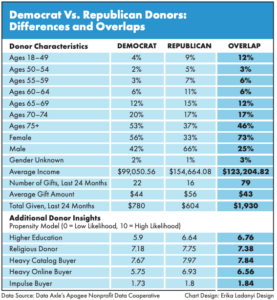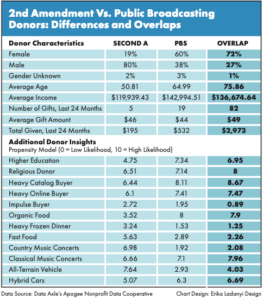Some Donors Put Politics Aside, Give To Opposite-Attracting NPOs

Photo from @DepositPhotos
Americans are divided along progressive and conservative lines when it comes to politics and often even the nonprofits they support. But exclusive new data shows there are Americans who give to both types of organizations, say a Second Amendment nonprofit and to public broadcasting.
Some donors also give to both democrat and republican political candidates.
The data shows those donors give significantly more than single ideology donors. An overlap donor tends to be married, averages 72.6 years old, has less income than most single ideology donors but tends to give thousands of dollars more than the more siloed advocates.
While the percentage of overlap donors is in the low single digitals, it is clear they are an easily identifiable group of donors who spread a much greater than average amount of their funds across a wider swath of organizations. This group, however, is aging out of the donor pool.
These are among the insights from exclusive analysis conducted by the The NonProfit Times on aggregated, anonymized donors modeled with the help of Data Axle Nonprofit, which has 25 million active donor records in its Apogee cooperative database. Progressive organizations and conservative organizations were modeled against each other to find similarities and differences in demographics and donor propensities.
Due to contractual confidentiality between Data Axle Nonprofit and those contributing to the Apogee cooperative database, the names of the organizations will not be disclosed publicly, although they are known to the editorial staff of The NonProfit Times. The overlap of donors to both types of organizations was low, between 1% and 3.5%.
The pairing were: Democrat vs. Republican candidates; Environmental vs. International Relief; Civil Rights vs. Religious Social Welfare; Second Amendment vs. Public Broadcasting; U.S. vs International Relief; and, Religious vs. Maternal Health. Assumptions should not be made as to the actual organizations represented in the silos.
The modeling started with 10 age groups, 18-24, 25-34, 35-44, 45-49, 50-54, 55-59, 60-64, 65-69, 70-74, and 75 and older. The overlap donor group was in low single digits until the age 65 to 69 group when it quickly went to 63% in one pairing.
Wealth was broken into three ranges, low ($0 – $137,999), medium ($138,000-$2,083,999) and high (at least $2,084,000+). Overlap donors tended to be in the middle range of assets with an average income of $115,878 and home value of $460,633 and of which 87% on average owned their homes.
The number of female donors in the overlap groups was 58.5% and 41.5% for men. The number skewed when it came to what could be considered gender specific causes. For example, the overlap in maternal health was 73% female.
The overlap donors do more than merely give across ideological lines. They made substantially more and frequent donations to a greater number of nonprofits. Across the six pairings, within the past 24 months overlap donors appeared on three to five times more donor lists than their siloed counterparts.
Overlap donors also tend to give with greater frequency. According to the data, their most recent donation was made one to two months more recently than those of the siloed funders. The recency finding suggests these donors are more likely to give outside of the traditional year-end campaign seasons, such as by becoming sustaining funders who have enrolled in automatic contribution programs.
The numbers back up this hypothesis: Overlap donors are observed to have made between 70 to just fewer than 100 contributions, in aggregate, during a 24-month period. This figure makes sense if a donor sets up six or seven monthly automatic contributions (as well as whatever one-offs they might do), and each month’s contribution is counted individually.
“Some new trends emerge when comparing donors who gave to both an environmental conservation-based mission and a religious international humanitarian mission. While these donors also tended to be more philanthropic than the average donor, they have some unique characteristics,” said Colin Anderson, general manager, Cooperative Databases at Data Axle.
“These donors didn’t simply support both causes because they have the means to do so. In fact, the opposite appears to be true,” Anderson said. “The donors who gave to both causes had a lower income and lower home value than the donors who only supported either the environmental conservation-based mission or the religious international humanitarian mission only,” he said.

The amounts overlap donors gave within each individual contribution tended to mirror those of the polarized donors. While there were deviations – sometimes these donors gave a little more, sometimes a little less — the actual dollars donated to a specific cause was in line with other donors — usually around $45 to $80, with a few exceptions. Again, this stands to reason because since overlap donors tend to be older donors, automatic contributions allow them to budget their magnanimousness within the confines of a fixed income.
That said, the total amount given by overlap donors was substantially greater than any of the polarized donors. Donors who fell into a silo usually reported between $400 and $1,000 in total contributions during a 24-month period. One polarized group, a second amendment-related nonprofit, reported biennial giving amounts much lower than the others. These donors most likely are paying their annual dues and are not responding to other entreaties. The firearms donors also had the lowest instances of being on multiple lists.
As for the overlap donors, their aggregate funding ranged between $1,900 and $4,800 for that 24-month period.
The data is “evidence that the media narrative of a polarized country doesn’t fully account for individuals’ views of what they want the world to look like. I suspect that donor attributes such as personality may impact donors’ giving choices and moderate the impact of political affiliation on those choices,” said Geoff Handy, senior director, USA Mass Market Revenue of the International Rescue Committee (IRC). The IRC is not one of the organizations examined in this story.
“From a fundraising perspective, the data suggests it might be worth it for charities to test a wider variety of nonprofits in list exchanges,” said Handy. “Are there areas of mission overlap that aren’t immediately apparent? Are there areas of messaging, such as through emotive words like ‘freedom’ or ‘compassion,’ that resonate across organizations that otherwise have different primary missions?,” he said.
Those donors who supported polar-opposite causes tended to be older and significantly more philanthropic on average than their peers. For example, 14% of donors and 36% of donors who gave to local public broadcast stations or to Second Amendment rights organizations are 75 or older respectively. While 63% of the donors who gave to both causes are 75 or older.
There was a significantly greater level of general giving activity from the donors who give to both causes. Comparing donors to democrat candidates vs. donors to republican candidates, the data shows donors who gave to both tended to give to three times more nonprofits across the entire co-op and gave four times as many total gifts.
For instance, overlap donors displayed a much higher level of direct mail responsiveness across all data sets. Within five of the six pairings, the overlap donors displayed a greater propensity for shopping via catalogs than either of the siloed categories. Conversely, they indexed much lower in their likelihood to be heavy online shoppers, usually showing up either as having a lower, or in a few cases, a middling propensity to shop digitally.
To some extent this is a result of their age. Older shoppers still tend to prefer direct mail compared to online channels, at least compared to younger cohorts, and these donors do skew older. But that’s likely only part of the story. Across the six pairings the overlap donors were usually (in some cases significantly) less likely to be considered “impulse buyers.” These donors’ purchases, and most likely their funding decisions, were the result of careful consideration.
Such consideration results from information, and in fundraising information often equates to detail-rich direct mail packages. With this in mind, the finding that in five of six pairings the overlap donors are much more likely to be identified as “low-risk investors” fits the picture of their persona.

The overlay group are not Luddites. In four of the six pairings, they topped the affinity for “Heavy Internet User.” That finding would seem to support a thirst for information. They are, as noted previously, not shopping as much as other donors but they are definitely online. Whether or not these are more likely to donate online or via direct mail is not known from this data. Multiple touches through online and offline channels has long been correlated with likelihood of donation via whatever channel.
Given the seeming aversion to impulse purchases, as well as the apparent desire for information, one might expect overlay donors not to identify as “shopaholics.” But among the six pairings the overlay donors indexed more toward identifying as such than not. This seeming incongruity might offer a key insight into how to approach these donors.
They are discerning, information-seeking shoppers and donors. But when they do make a purchase, they apparently are susceptible to the dopamine (the brain’s “pleasure hormone”) hit experienced with such a purchase. It is likely part of the impulse to spread largesse among a large number of well-researched nonprofits to achieve dopamine release similar to a well-considered purchase.
Donors who gave to both a fundamentally religious driven mission and a mission supporting women’s maternal health exhibited some interesting characteristics. This pool of donors gave roughly five times more gifts across the entire co-op than those donors who gave to only one or the other. They also tended to be much more active, having given to their last charity only 89 days ago as compared to the siloed donors who were nearly double that having given to their last charity 168 days ago on average. Following a similar pattern as seen across most comparisons, these donors also tended to be older.
The post Some Donors Put Politics Aside, Give To Opposite-Attracting NPOs appeared first on The NonProfit Times.









Leave a Reply